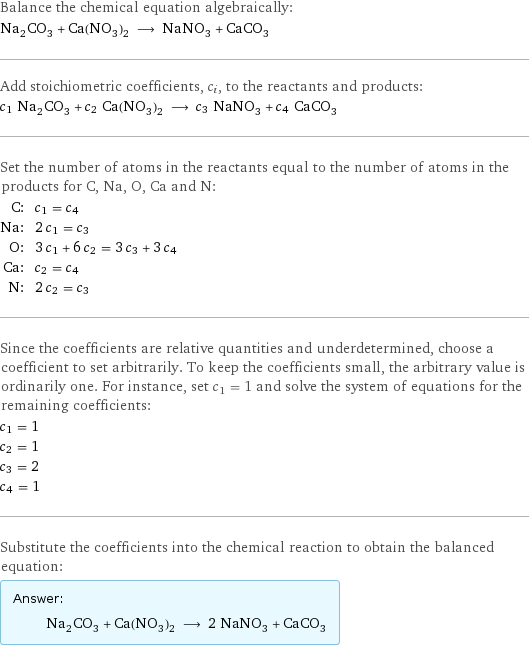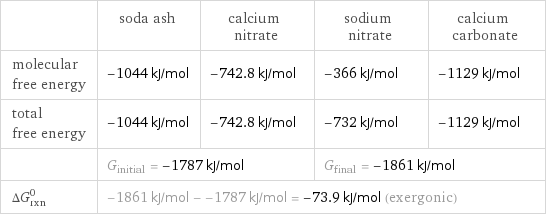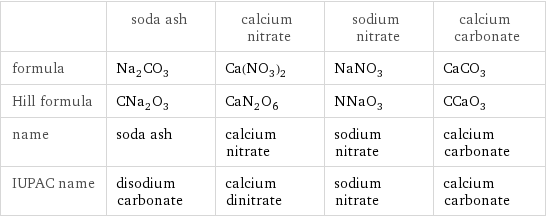Input interpretation

Na_2CO_3 soda ash + Ca(NO_3)_2 calcium nitrate ⟶ NaNO_3 sodium nitrate + CaCO_3 calcium carbonate
Balanced equation

Balance the chemical equation algebraically: Na_2CO_3 + Ca(NO_3)_2 ⟶ NaNO_3 + CaCO_3 Add stoichiometric coefficients, c_i, to the reactants and products: c_1 Na_2CO_3 + c_2 Ca(NO_3)_2 ⟶ c_3 NaNO_3 + c_4 CaCO_3 Set the number of atoms in the reactants equal to the number of atoms in the products for C, Na, O, Ca and N: C: | c_1 = c_4 Na: | 2 c_1 = c_3 O: | 3 c_1 + 6 c_2 = 3 c_3 + 3 c_4 Ca: | c_2 = c_4 N: | 2 c_2 = c_3 Since the coefficients are relative quantities and underdetermined, choose a coefficient to set arbitrarily. To keep the coefficients small, the arbitrary value is ordinarily one. For instance, set c_1 = 1 and solve the system of equations for the remaining coefficients: c_1 = 1 c_2 = 1 c_3 = 2 c_4 = 1 Substitute the coefficients into the chemical reaction to obtain the balanced equation: Answer: | | Na_2CO_3 + Ca(NO_3)_2 ⟶ 2 NaNO_3 + CaCO_3
Structures

+ ⟶ +
Names

soda ash + calcium nitrate ⟶ sodium nitrate + calcium carbonate
Reaction thermodynamics
Enthalpy

| soda ash | calcium nitrate | sodium nitrate | calcium carbonate molecular enthalpy | -1131 kJ/mol | -938.2 kJ/mol | -467.9 kJ/mol | -1208 kJ/mol total enthalpy | -1131 kJ/mol | -938.2 kJ/mol | -935.8 kJ/mol | -1208 kJ/mol | H_initial = -2069 kJ/mol | | H_final = -2143 kJ/mol | ΔH_rxn^0 | -2143 kJ/mol - -2069 kJ/mol = -74.5 kJ/mol (exothermic) | | |
Gibbs free energy

| soda ash | calcium nitrate | sodium nitrate | calcium carbonate molecular free energy | -1044 kJ/mol | -742.8 kJ/mol | -366 kJ/mol | -1129 kJ/mol total free energy | -1044 kJ/mol | -742.8 kJ/mol | -732 kJ/mol | -1129 kJ/mol | G_initial = -1787 kJ/mol | | G_final = -1861 kJ/mol | ΔG_rxn^0 | -1861 kJ/mol - -1787 kJ/mol = -73.9 kJ/mol (exergonic) | | |
Equilibrium constant
![Construct the equilibrium constant, K, expression for: Na_2CO_3 + Ca(NO_3)_2 ⟶ NaNO_3 + CaCO_3 Plan: • Balance the chemical equation. • Determine the stoichiometric numbers. • Assemble the activity expression for each chemical species. • Use the activity expressions to build the equilibrium constant expression. Write the balanced chemical equation: Na_2CO_3 + Ca(NO_3)_2 ⟶ 2 NaNO_3 + CaCO_3 Assign stoichiometric numbers, ν_i, using the stoichiometric coefficients, c_i, from the balanced chemical equation in the following manner: ν_i = -c_i for reactants and ν_i = c_i for products: chemical species | c_i | ν_i Na_2CO_3 | 1 | -1 Ca(NO_3)_2 | 1 | -1 NaNO_3 | 2 | 2 CaCO_3 | 1 | 1 Assemble the activity expressions accounting for the state of matter and ν_i: chemical species | c_i | ν_i | activity expression Na_2CO_3 | 1 | -1 | ([Na2CO3])^(-1) Ca(NO_3)_2 | 1 | -1 | ([Ca(NO3)2])^(-1) NaNO_3 | 2 | 2 | ([NaNO3])^2 CaCO_3 | 1 | 1 | [CaCO3] The equilibrium constant symbol in the concentration basis is: K_c Mulitply the activity expressions to arrive at the K_c expression: Answer: | | K_c = ([Na2CO3])^(-1) ([Ca(NO3)2])^(-1) ([NaNO3])^2 [CaCO3] = (([NaNO3])^2 [CaCO3])/([Na2CO3] [Ca(NO3)2])](../image_source/19628e16d9f23db196330e190408fb12.png)
Construct the equilibrium constant, K, expression for: Na_2CO_3 + Ca(NO_3)_2 ⟶ NaNO_3 + CaCO_3 Plan: • Balance the chemical equation. • Determine the stoichiometric numbers. • Assemble the activity expression for each chemical species. • Use the activity expressions to build the equilibrium constant expression. Write the balanced chemical equation: Na_2CO_3 + Ca(NO_3)_2 ⟶ 2 NaNO_3 + CaCO_3 Assign stoichiometric numbers, ν_i, using the stoichiometric coefficients, c_i, from the balanced chemical equation in the following manner: ν_i = -c_i for reactants and ν_i = c_i for products: chemical species | c_i | ν_i Na_2CO_3 | 1 | -1 Ca(NO_3)_2 | 1 | -1 NaNO_3 | 2 | 2 CaCO_3 | 1 | 1 Assemble the activity expressions accounting for the state of matter and ν_i: chemical species | c_i | ν_i | activity expression Na_2CO_3 | 1 | -1 | ([Na2CO3])^(-1) Ca(NO_3)_2 | 1 | -1 | ([Ca(NO3)2])^(-1) NaNO_3 | 2 | 2 | ([NaNO3])^2 CaCO_3 | 1 | 1 | [CaCO3] The equilibrium constant symbol in the concentration basis is: K_c Mulitply the activity expressions to arrive at the K_c expression: Answer: | | K_c = ([Na2CO3])^(-1) ([Ca(NO3)2])^(-1) ([NaNO3])^2 [CaCO3] = (([NaNO3])^2 [CaCO3])/([Na2CO3] [Ca(NO3)2])
Rate of reaction
![Construct the rate of reaction expression for: Na_2CO_3 + Ca(NO_3)_2 ⟶ NaNO_3 + CaCO_3 Plan: • Balance the chemical equation. • Determine the stoichiometric numbers. • Assemble the rate term for each chemical species. • Write the rate of reaction expression. Write the balanced chemical equation: Na_2CO_3 + Ca(NO_3)_2 ⟶ 2 NaNO_3 + CaCO_3 Assign stoichiometric numbers, ν_i, using the stoichiometric coefficients, c_i, from the balanced chemical equation in the following manner: ν_i = -c_i for reactants and ν_i = c_i for products: chemical species | c_i | ν_i Na_2CO_3 | 1 | -1 Ca(NO_3)_2 | 1 | -1 NaNO_3 | 2 | 2 CaCO_3 | 1 | 1 The rate term for each chemical species, B_i, is 1/ν_i(Δ[B_i])/(Δt) where [B_i] is the amount concentration and t is time: chemical species | c_i | ν_i | rate term Na_2CO_3 | 1 | -1 | -(Δ[Na2CO3])/(Δt) Ca(NO_3)_2 | 1 | -1 | -(Δ[Ca(NO3)2])/(Δt) NaNO_3 | 2 | 2 | 1/2 (Δ[NaNO3])/(Δt) CaCO_3 | 1 | 1 | (Δ[CaCO3])/(Δt) (for infinitesimal rate of change, replace Δ with d) Set the rate terms equal to each other to arrive at the rate expression: Answer: | | rate = -(Δ[Na2CO3])/(Δt) = -(Δ[Ca(NO3)2])/(Δt) = 1/2 (Δ[NaNO3])/(Δt) = (Δ[CaCO3])/(Δt) (assuming constant volume and no accumulation of intermediates or side products)](../image_source/c3f1e1e03adfe39a5ecfcaaf10988f1b.png)
Construct the rate of reaction expression for: Na_2CO_3 + Ca(NO_3)_2 ⟶ NaNO_3 + CaCO_3 Plan: • Balance the chemical equation. • Determine the stoichiometric numbers. • Assemble the rate term for each chemical species. • Write the rate of reaction expression. Write the balanced chemical equation: Na_2CO_3 + Ca(NO_3)_2 ⟶ 2 NaNO_3 + CaCO_3 Assign stoichiometric numbers, ν_i, using the stoichiometric coefficients, c_i, from the balanced chemical equation in the following manner: ν_i = -c_i for reactants and ν_i = c_i for products: chemical species | c_i | ν_i Na_2CO_3 | 1 | -1 Ca(NO_3)_2 | 1 | -1 NaNO_3 | 2 | 2 CaCO_3 | 1 | 1 The rate term for each chemical species, B_i, is 1/ν_i(Δ[B_i])/(Δt) where [B_i] is the amount concentration and t is time: chemical species | c_i | ν_i | rate term Na_2CO_3 | 1 | -1 | -(Δ[Na2CO3])/(Δt) Ca(NO_3)_2 | 1 | -1 | -(Δ[Ca(NO3)2])/(Δt) NaNO_3 | 2 | 2 | 1/2 (Δ[NaNO3])/(Δt) CaCO_3 | 1 | 1 | (Δ[CaCO3])/(Δt) (for infinitesimal rate of change, replace Δ with d) Set the rate terms equal to each other to arrive at the rate expression: Answer: | | rate = -(Δ[Na2CO3])/(Δt) = -(Δ[Ca(NO3)2])/(Δt) = 1/2 (Δ[NaNO3])/(Δt) = (Δ[CaCO3])/(Δt) (assuming constant volume and no accumulation of intermediates or side products)
Chemical names and formulas

| soda ash | calcium nitrate | sodium nitrate | calcium carbonate formula | Na_2CO_3 | Ca(NO_3)_2 | NaNO_3 | CaCO_3 Hill formula | CNa_2O_3 | CaN_2O_6 | NNaO_3 | CCaO_3 name | soda ash | calcium nitrate | sodium nitrate | calcium carbonate IUPAC name | disodium carbonate | calcium dinitrate | sodium nitrate | calcium carbonate
Substance properties

| soda ash | calcium nitrate | sodium nitrate | calcium carbonate molar mass | 105.99 g/mol | 164.09 g/mol | 84.994 g/mol | 100.09 g/mol phase | solid (at STP) | solid (at STP) | solid (at STP) | solid (at STP) melting point | 851 °C | 562 °C | 306 °C | 1340 °C boiling point | 1600 °C | | | density | | 2.5 g/cm^3 | 2.26 g/cm^3 | 2.71 g/cm^3 solubility in water | soluble | soluble | soluble | insoluble dynamic viscosity | 0.00355 Pa s (at 900 °C) | | 0.003 Pa s (at 250 °C) |
Units
